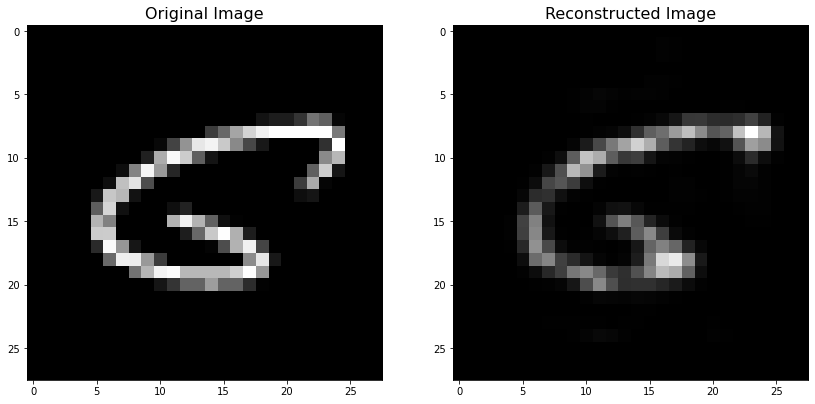Anomaly Detection with Autoencoders¶
Version 1.1
(C) 2020 - Umberto Michelucci, Michela Sperti
This notebook is part of the book Applied Deep Learning: a case based approach, 2nd edition from APRESS by U. Michelucci and M. Sperti.
The purpose of this notebook is to show you a possible application of autoencoders: anomaly detection, on a dataset taken from the real world.
Notebook Learning Goals¶
At the end of this notebook you will be able to build a simple anomaly detection algorithm using autoencoders with Keras (built with Dense layers).
Libraries and Dataset Import¶
This section contains the necessary libraries (such as tensorflow or pandas) you need to import to run the notebook.
# general libraries
import numpy as np
import pandas as pd
import time
import sys
import seaborn as sns
import matplotlib.pyplot as plt
# tensorflow libraries
import tensorflow as tf
import tensorflow.keras as keras
from tensorflow.keras.layers import Input, Dense
from tensorflow.keras.models import Model
MNIST and FASHION MNIST dataset¶
For this notebook we will use two datasets:
You can check the two datasets with the links above. They can be easily imported using Keras. Below you can see how easy is using tensorflow.keras.datasets.
from keras.datasets import mnist
import numpy as np
(mnist_x_train, mnist_y_train), (mnist_x_test, mnist_y_test) = mnist.load_data()
As usual we will do the typical normalisation of the datasets as you can see below. At this point in the book you should be able to understand the code below easily.
mnist_x_train = mnist_x_train.astype('float32') / 255.
mnist_x_test = mnist_x_test.astype('float32') / 255.
mnist_x_train = mnist_x_train.reshape((len(mnist_x_train), np.prod(mnist_x_train.shape[1:])))
mnist_x_test = mnist_x_test.reshape((len(mnist_x_test), np.prod(mnist_x_test.shape[1:])))
from keras.datasets import fashion_mnist
import numpy as np
(fashion_x_train, fashion_y_train), (fashion_x_test, fashion_y_test) = fashion_mnist.load_data()
Note that we are doing the same normalisation for the fashion MNIST datasets as for the classical MNIST.
fashion_x_train = fashion_x_train.astype('float32') / 255.
fashion_x_test = fashion_x_test.astype('float32') / 255.
fashion_x_train = fashion_x_train.reshape((len(fashion_x_train), np.prod(fashion_x_train.shape[1:])))
fashion_x_test = fashion_x_test.reshape((len(fashion_x_test), np.prod(fashion_x_test.shape[1:])))
Problem to be solved¶
Now let’s explain better what anomaly detection means. Let’s create a special dataset that is made of the 10000 images of the MNIST test dataset and one single image from the fashion MNIST dataset. Our goal in this notebook will be to find this image automatically without looking at them. Can we do it?
x_test = np.concatenate((mnist_x_test, fashion_x_test[0].reshape(1,784)))
print(x_test.shape)
(10001, 784)
All the images in the MNIST dataset are hand written digits. Below you can see an example of one of them.
plt.gray()
plt.tick_params(axis = 'x', which = 'both', bottom = False, top = False,
labelbottom = False)
plt.tick_params(axis = 'y', which = 'both', left = False, right = False,
labelleft = False)
plt.imshow(mnist_x_test[10].reshape(28, 28))
<matplotlib.image.AxesImage at 0x7fa4c87dee50>
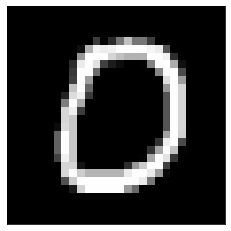
But the images in the fashion MNIST are all gray level images of clothing items. In particular the one we are adding to the hand written digits is the image of a show that can be seen below.
plt.gray()
plt.tick_params(axis = 'x', which = 'both', bottom = False, top = False,
labelbottom = False)
plt.tick_params(axis = 'y', which = 'both', left = False, right = False,
labelleft = False)
plt.imshow(fashion_x_test[0].reshape(28, 28))
plt.show()
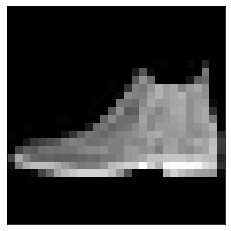
Function to Create the Autoencoder¶
Now we need to create the keras model. An autoencoder is made of two main parts: an encoder and a decoder. The function below create_autoencoders() returns the following parts as separate models:
the encoder
the decoder
the complete model, when the encoder and decoder are joined in one model.
def create_autoencoders(feature_layer_dim = 16):
input_img = Input(shape = (784,), name = 'Input_Layer')
# 784 is the total number of pixels of MNIST images
# The layer encoded has a dimension equal to feature_layer_dim and contains
# the encoded input (therefore the name)
encoded = Dense(feature_layer_dim, activation = 'relu', name = 'Encoded_Features')(input_img)
decoded = Dense(784, activation = 'sigmoid', name = 'Decoded_Input')(encoded)
autoencoder = Model(input_img, decoded)
encoder = Model(input_img, encoded)
encoded_input = Input(shape = (feature_layer_dim,))
decoder = autoencoder.layers[-1]
decoder = Model(encoded_input, decoder(encoded_input))
return autoencoder, encoder, decoder
Autoencoder with layers with \((784,64,784)\) neurons.¶
As a first step let’s create an autoencoder with the layer dimensions of \((784, 64, 784)\).
autoencoder, encoder, decoder = create_autoencoders(64)
keras.utils.plot_model(autoencoder, show_shapes = True)
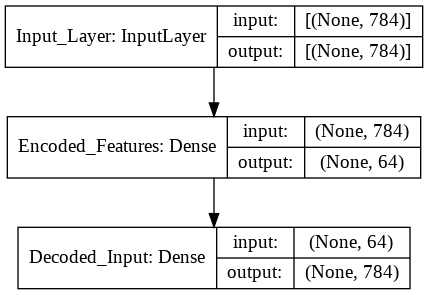
As for any Keras model we need to compile the model and fit it to the data. As you can see we don’t need any custom code to work with autoencoders. A simple model definition \(\rightarrow\) compile \(\rightarrow\) fit is enough.
autoencoder.compile(optimizer = 'adam', loss = 'binary_crossentropy')
history = autoencoder.fit(mnist_x_train, mnist_x_train,
epochs = 30,
batch_size = 256,
shuffle = True,
validation_data = (mnist_x_test, mnist_x_test),
verbose = 0)
encoded_imgs = encoder.predict(x_test)
decoded_imgs = decoder.predict(encoded_imgs)
We can now calculate the reconstruction error (\(\textrm{RE}^{[j]}\)) of image \(j\) simply calculating
where \(x_i^{[j]}\) is the \(i^{th}\) pixel value of the \(j\) image, and the sum is over all the pixels.
RE = ((x_test - decoded_imgs)**2).mean(axis = 1)
RE_original = RE.copy()
The \(\textrm{RE}\) for the image of the shoe we added can be easily printed since it is the last element of the vector RE.
RE[-1]
0.057362944
It is easy to see that this is the highest \(\textrm{RE}\) we have for all 10000 images by far. We can check this by sorting the RE vector.
RE.sort()
print(RE[9990:])
[0.0170981 0.01732995 0.01793869 0.01808861 0.01859306 0.0186063
0.01883012 0.02222204 0.02264616 0.02529096 0.05736294]
Notice that if you re-execute the whole notebook you can obtain slightly different results, due to the random initialization of the network’s weights.
You can see that the second highest reconstruction error (0.02529096) is less than half of the \(\textrm{RE}\) for the added image (0.05736294). Below you can see the original image and the one that the trained autoencoder has reconstructed. You can see how the reconstructed image does not look like the original at all.
Biggest RE¶
biggest_re_pos = np.argmax(RE_original)
fig = plt.figure(figsize = (14, 7))
ax = fig.add_subplot(1, 2, 1)
plt.title('Original Image', fontsize = 16)
plt.gray()
plt.tick_params(axis = 'x', which = 'both', bottom = False, top = False,
labelbottom = False)
plt.tick_params(axis = 'y', which = 'both', left = False, right = False,
labelleft = False)
plt.imshow(x_test[biggest_re_pos].reshape(28, 28))
ax = fig.add_subplot(1, 2, 2)
plt.title('Reconstructed Image', fontsize = 16)
plt.gray()
plt.tick_params(axis = 'x', which = 'both', bottom = False, top = False,
labelbottom = False)
plt.tick_params(axis = 'y', which = 'both', left = False, right = False,
labelleft = False)
plt.imshow(decoded_imgs[biggest_re_pos].reshape(28, 28))
<matplotlib.image.AxesImage at 0x7fa4be9a0d10>
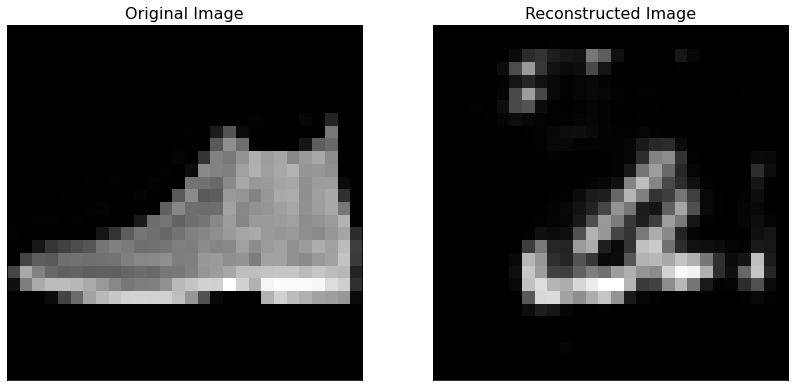
The autoencoder is able to reconstruct perfectly hand-written images, as you can see below.
Second biggest RE¶
The image shown below (and its reconstructed version) is the one with the second highest reconstruction error. The reason is clear, this image does not seems like a hand-written digit at all! That could even count as an outlier in the dataset.
second_biggest_re_pos = list(RE_original).index(RE[-2])
fig = plt.figure(figsize = (14, 7))
ax = fig.add_subplot(1, 2, 1)
plt.tick_params(axis = 'x', which = 'both', bottom = False, top = False,
labelbottom = False)
plt.tick_params(axis = 'y', which = 'both', left = False, right = False,
labelleft = False)
plt.title('Original Image', fontsize = 16)
plt.gray()
plt.imshow(x_test[second_biggest_re_pos].reshape(28, 28))
ax = fig.add_subplot(1, 2, 2)
plt.tick_params(axis = 'x', which = 'both', bottom = False, top = False,
labelbottom = False)
plt.tick_params(axis = 'y', which = 'both', left = False, right = False,
labelleft = False)
plt.title('Reconstructed Image', fontsize = 16)
plt.gray()
plt.imshow(decoded_imgs[second_biggest_re_pos].reshape(28, 28))
<matplotlib.image.AxesImage at 0x7fa4be972a90>
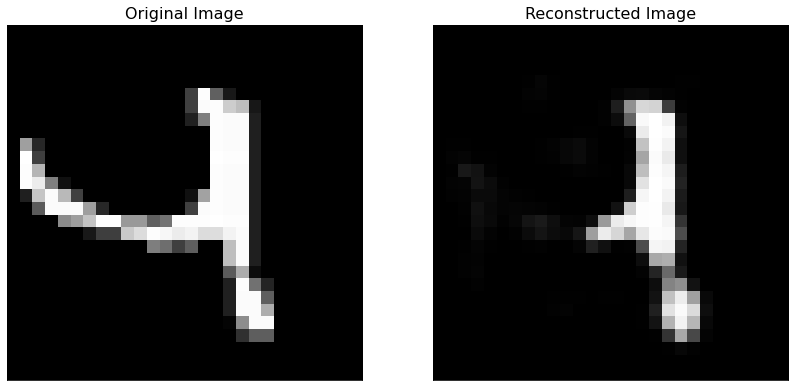
Third biggest RE¶
third_biggest_re_pos = list(RE_original).index(RE[-3])
fig = plt.figure(figsize = (14, 7))
ax = fig.add_subplot(1, 2, 1)
plt.title('Original Image', fontsize = 16)
plt.gray()
plt.imshow(x_test[third_biggest_re_pos].reshape(28,28))
ax = fig.add_subplot(1, 2, 2)
plt.title('Reconstructed Image', fontsize = 16)
plt.gray()
plt.imshow(decoded_imgs[third_biggest_re_pos].reshape(28,28))
<matplotlib.image.AxesImage at 0x7fa4be83c210>
